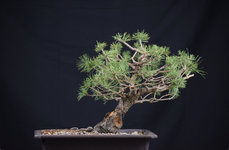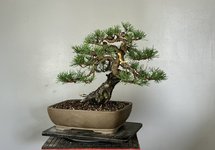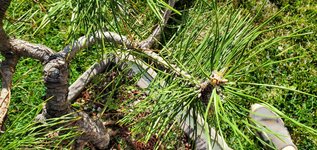With every pine species I've had success with, the broad strokes are mostly the same. Works well for scots, lodgepole, shore, JRP, JBP, JWP, and korean pines:
-
Transition the root system into non-junky, non-dense, non-decaying, aggregate, porous, pea-sized, durable soil (if not yet done so, and either gradually or suddenly, depending on effective age of tree). For me, this is pumice/lava. Chunky, colonizer-gauge, air-breathing roots in my pines seem to correlate with vigorous shoot tips with lustrous, skin-poke sharp, waxy, good-colored needles
-
Get the pine's entire foliage in direct blazing sun and occasionally rotate for exposure. Ideally, reward the tree that needs this treatment the most with a location that gets the most sun hours of out all locations.
- I
ncrease rate of transpiration and respiration for higher vigor. You want to cycle water/air through the soil rapidly, since both transpiration and respiration are drivers of growth (see:
Physiology of Woody Plants, Stephen Pallardy). This means a
taller soil volume (all other things equal, I wish I could go back in time and avoid mindlessly increasing all dimensions of pine pots as opposed to exclusively column height, live and learn...). Along with this, ideally, expose that soil volume to a higher surface area of air flow (pond baskets, mesh grow boxes, etc). Except for pines which are planted out in the field, the highest vigor I have seen is when using pond baskets and colanders or similar-construction pots. I stack them vertically as I see roots poke out the bottom to keep root length increasing. I feel like my stacked-colander pines grow much faster than ones in flats, even with the flats having the large top surface area for air flow.
-
Lower the branches on which interior budding is desired. There are many theories and hints in the academic literature about how this all works, but I've observed that the interiors of branches aren't going to backbud as willingly if they're shaded out, or if their
tips are super vigorous while
also sitting higher than those interior dormant buds. Notice
@PeaceLoveBonsai 's comment about wiring for aesthetics, where in the attached before/after photo you see the initially upturned branches now nicely lowered down, which exposes interiors to light and prevents tip-generated auxin from migrating up from the tips into those interiors, further preventing dormant bud suppression in those interiors. Some academic literature suggests that dormant buds that see a lower auxin content (produced by shoot tips) relative to cytokinin content (produced by the roots) are more likely to develop, all other things equal, and auxin (as Ryan Neil says) "
doesn't like to go up hill". If you believe the theory is true, then combining this strategy with aggressive root expansion means that the average interior wood now has an excess in cytokinin and a deficit of auxin. Scots can push buds out of relatively old wood directly out of the trunk in these conditions (shore pine too).
-
Allow branches to attain length and vigor, like
@p_anova said, higher sap "traffic" flowing past dormant buds, all other things equal, raises the likelihood they begin to develop.
-
Reduce the total number of tips at the ends of those vigorous branches at end of year (
@p_anova 's suggestion again). If our suspicions are correct about tip-emitted auxin suppressing interior dormant buds, then fewer emitters at the tips raises the likelihood of interior bud development. Also even if the prevalent theories about auxin are wrong or "not the whole story", there's also the dominating effect of the tip shoot's demand for sugar (dominating over those interior dormant buds or existing shoots, that is). As
this academic paper states, "
the shoot tip's strong demand for sugars inhibits axillary bud outgrowth by limiting the amount of sugar translocated to those buds". Finally, also seems that increasing the distance between the vigorous tip(s) and the to-be-preserved interior shoots enhances the development of the latter. You can see some of this in the "poodling" strategies used by Telperion Farms / Gary Wood and also many Japanese or Japan-trained pine growers. I personally believe (anecdotally) that this strategy also works for branches too, not just the apex.
I like to think the last point as a personal rule of: "
ALL pine tips are eventually sacrificial". Pass the baton inwards as the interior strengthens, but also, weaken or distance the exterior when the time is right to ensure the best outcome (or remove the exterior entirely when the interior has become is strong enough to stand on its own).






